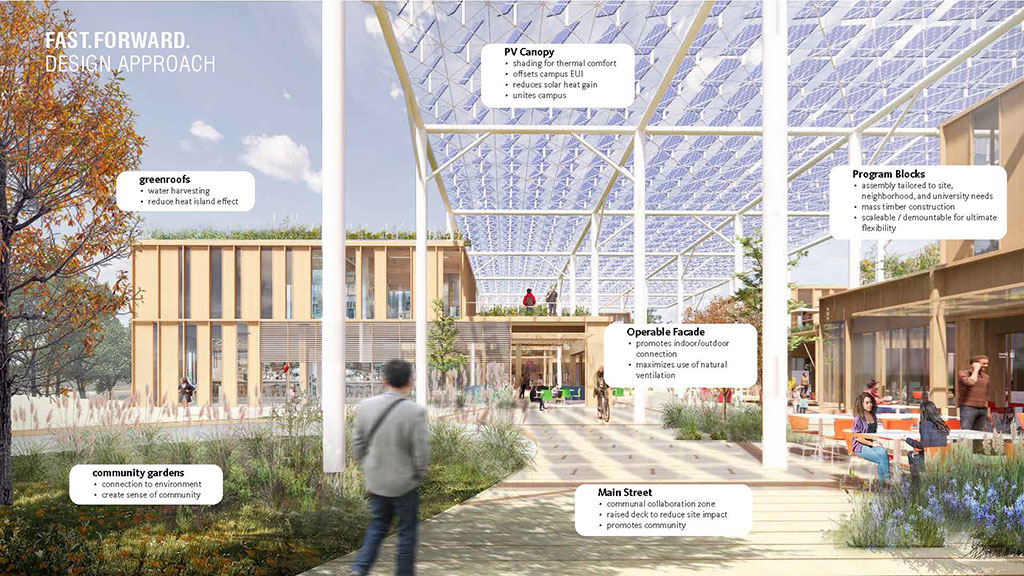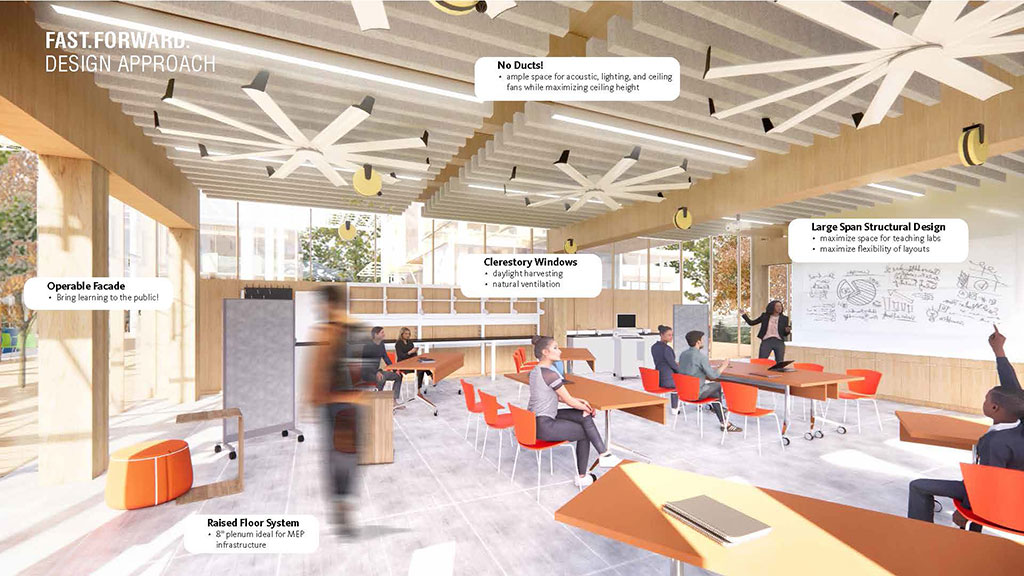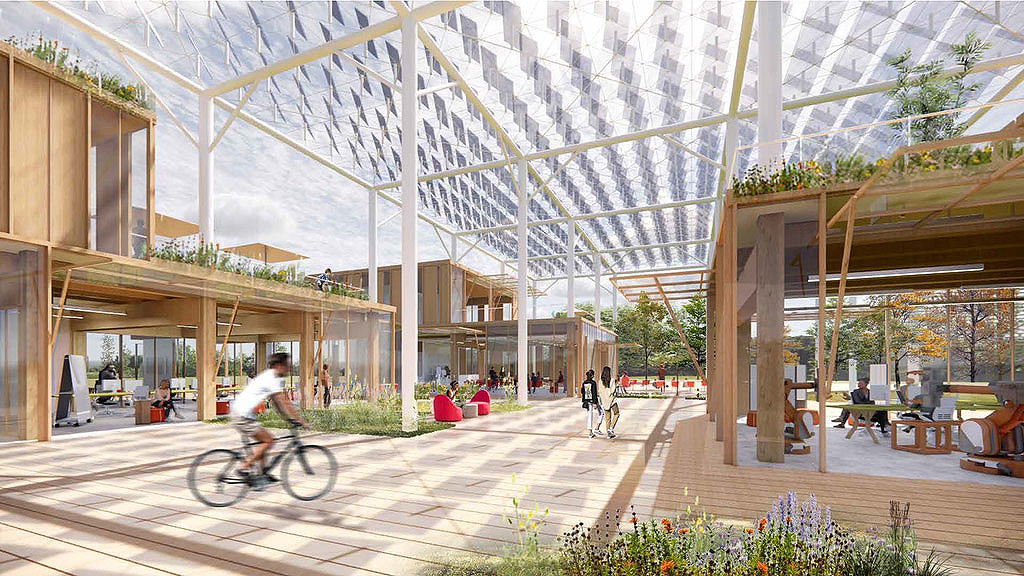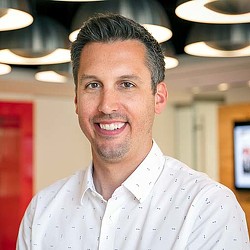Fast.Forward.: A New Model for Academic Science Facilities
October 09, 2023 | By Michael Kocher
Higher education academic science facilities are facing a unique confluence of circumstances as we confront solutions to climate change and public health crises. On one hand, colleges and universities currently house some of the healthiest, most sustainable, flexible, and energy-efficient science buildings in the world. They are among the most open to innovative and progressive building concepts as the world paves the way for carbon neutrality. Their uniquely powerful position in the world of health, economics, and technology also enables them to serve as community resources during health emergencies such as the COVID-19 pandemic.
On the other hand, current academic science facilities can cost up to five times more than a traditional office building to complete, on top of already rising construction costs. At the same time, U.S. undergraduate enrollment dropped 8% from 2019 to 2022, according to data from the National Student Clearinghouse. More than one million fewer students are enrolled in college now than before the pandemic began.
To create a vision for the future of academic science facilities that builds on and augments their successes while addressing the needs of tomorrow, we created a data-powered concept for how academic science facilities of the future will perform, feel, and look. Through ongoing research funded by the Gensler Research Institute, we collaborated with Thornton Tomasetti — structural engineers and sustainability consultants — and Van Zelm — mechanical, electrical, and plumbing engineers. This culminated in Fast.Forward., a conceptual design approach for the future of academic science facilities that focuses on mitigating cost, increasing flexibility, and supporting resilience.
We tested our design approach within different sites across four different cities in the U.S. We chose sites along and within existing green infrastructure projects — specifically the Beltline in Atlanta, the Don Lands in Toronto, Bayous in Houston, the Englewood Argo-Eco District in Chicago, and LA River in Los Angeles — that aim to rebuild local ecosystems, address resilience measures to mitigate climate change, and enhance mobility. By envisioning Fast.Forward. along green infrastructure developments within our cities, we aim to support resilience initiatives while bridging the gap between campus and community. This creates an opportunity to develop a pipeline of scientific exploration for our youth to support life-long learning or as training space for underserved communities without the financial means to attend traditional colleges and universities.

Constructing for optimal efficiency, adaptability, and reuse
Fast.Forward. is designed to meet the dynamic needs of today’s science facilities while being changeable and adaptable for the future. It conceptualizes a collapsible, modular structure that can be quickly adapted to meet the demands of its users. The structure is built using a kit of parts designed to erect quickly, efficiently, and for minimal disturbance of the site — making construction up to 50% faster. This includes two modules that can be organized and arranged to create an uninterrupted floorplate that form larger volumes based on the program, use, and need. Each deployment is tailored to suit the demands of the individual site and organization. These modules can be constructed in half the time of the conventional spread footing, steel frame, and composite deck construction.
A sustainable mass timber framing system is designed to optimize the speed of erection and dismantlement for reuse. This prefabricated mass timber ribbed panel floor framing system is shop fabricated and shipped to the site for just-in-time construction, greatly reducing on-site construction time and associated costs, while also meeting stringent structural criteria.
Using helical piles — a cost-effective, easy-to-install, and minimally invasive foundation system — allows Fast.Forward. to lightly touch the land and minimize impacts to existing ecosystems. In combination with the mass timber framing system, Fast.Forward.’s structural system will utilize 50% less embodied carbon than a conventional framing and foundation system.
The kit-of-parts facilities can accommodate multiple uses, with space for future infrastructure. By utilizing a raised radiant floor system, interior spaces are able to utilize the full floor to ceiling space for future uses and infrastructure. Operable windows are located at 10’ above the finished floor for fresh air intake and night flushing opportunities to maximize passive measures as local climate conditions allow.
To extend the lifespan of Fast.Forward. all mass timber components of the framing system are designed to be dismantled and reused in a similar capacity up to three times. The construction of a two-story, 20,000-square-foot Fast.Forward. facility would reduce the embodied carbon by 170 tons of carbon dioxide emissions when compared to a conventional structural steel and composite beam and slab building. If the framing system is reused once, this represents 75% less embodied carbon compared to two new conventional buildings. Once the system has been used a third time, this represents 85% less embodied carbon compared to three new buildings.

Designing a net positive science facility
Fast.Forward. uses 60% less energy than a conventional academic science building. Electricity provides heating, cooling, lighting, and general electric usage while the use of ground source heat pumps provides maximum operating efficiency in all climates. The combined use of underfloor air distribution — eliminating the need for ducted air systems — and radiant heating and cooling, ceiling fans, and utilization of natural ventilation further contributes to the low energy use.
The facility incorporates an adaptable photovoltaic canopy design to exceed the site’s energy demand. The canopy is developed as a module that can be multiplied depending on the facility’s area and energy usage, easily scaling up or down over time to meet evolving program needs. On-site battery storage is provided to allow photovoltaic systems to eliminate any required electricity from the utility grid during periods of peak electrical demand. This minimizes operational costs and facilitates efficient performance of the electrical grid. The canopy produces 25-30% surplus energy for public use.
Additionally, a natural plus mechanically induced ventilation system will be used to reject heat during moderate weather conditions. The system consists of operable windows at the building perimeter, which would be opened when the proper air conditions exist. When direct ventilation from these is not sufficient for cooling, one or more exhaust fans will be utilized to provide additional natural ventilation.
Overall, Fast.Forward. has a 53% reduction in carbon dioxide emissions associated with building operation and a 150% net positive reduction in actual carbon because of renewable generation. Combined with faster and cheaper construction of facilities with a flexible and adaptable layout, we envision future science facilities that meet the changing demands of the academic science campus.
For media inquiries, email .

